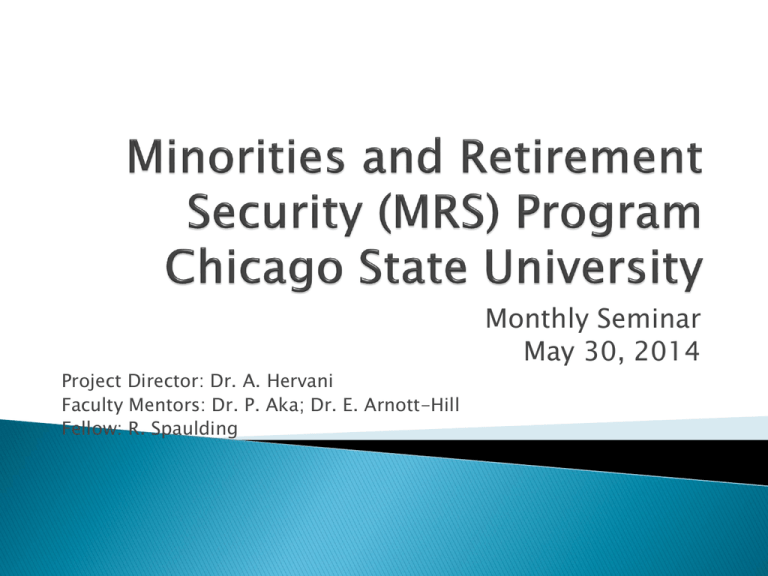MRS_Program_Presentation
advertisement

Monthly Seminar May 30, 2014 Project Director: Dr. A. Hervani Faculty Mentors: Dr. P. Aka; Dr. E. Arnott-Hill Fellow: R. Spaulding Baby Boomers Elderly Early retirees Singles/Head of households Gender - Female Mid-50s Ethnic groups – African-Americans, Hispanics Entrepreneurs Socio-economic changes: Availability of employer retirement benefits (changes from defined-benefit plans to defined-contribution plans to individual plans) Forced early retirement Poverty Health Social Security Savings Investments Financial knowledge (pension incentives, income tax credits) Financial practices (saving, budgeting, personal decision-making) Wealth vs Income Wealth gap Gender gap Elder care; long-term care Health; disabilities, chronic illness U.S. Social Security Administration/Modeling Income in the Near Term (MINT)/ Micro-simulation Eurostat & U.S. Census Bureau/European Union Statistics on Income and Living Conditions (EU-SILC), U.S. Panel Study of Income Dynamics (US-PSID)/Comparative analysis U.S. Census of Population and Housing/ 5% Public Use Microdata Sample (PUMS)/ Multivariate Models National Institute on Aging & Social Security Administration/University of Michigan Health and Retirement Study (HRS), Waves 1-4/multivariate models; simulations, structural retirement model, descriptive statistics, comparatives Survey of Consumer Finances (SCF)/Urban Institute’s DYNASIM3/micro-simulation model Statistics Canada’s Research Data Centre/2009 Canadian Financial Capability Survey (CFCS)/Multivariate, regression analyses Bureau of Labor Statistics/National Longitudinal Survey of Mature Women (NLSMW)/Hierarchical linear model Government benefits (support, subsidies) Fringe benefits (other compensation, i.e. education reimbursement) Data collection (disaggregation by race, gender, ethnicity) Opportunities (job training) Incentives to save Health insurance (adequate protection) Financial education (schools, employers) Bayer, P. J., Bernheim, B. D., & Scholz, J. K. (2009). The effects of financial education in the Workplace: Evidence from a survey of employers. Economic Inquiry, Western Economic Association International, 47(4), 605-624. Berry, B. (2006). What accounts for race and ethnic differences in parental financial transfers to adult children in the United States? Journal of Family Issues, 27(11), 1583-1604. Brimmer, A. F. (1988). Income, wealth, and investment behavior in the black community. The American Economic Review, 1988, 78(2), 151-155. Butrica, B. A., Murphy, D. P., & Zedlewski, S. R. (2009). How many struggle to get by in retirement? The Gerontologist, 50(4), 482-494. Chan, S. & Stevens, A. H. (2008). What you don’t know can’t help you: Pension knowledge and retirement decision-making. The Review of Economics and Statistics, 90(2), 253-266. Finkelstein, E. S. Reid, M. C., Kleppinger, A., Pillemer, K. & Robison, J. (2012). Are baby boomers who care for their older parents planning for their own future long-term care needs? Journal of Aging & Social Policy, 24(1), 29-45. Haas III, W. H., Bradley, D. E., Longino Jr., C. F., Stoller, E. P., & Serow, W. J. (2006). In retirement migration, who counts? A methodological question with economic policy implications. The Gerontologist, 46(6), 815-820. Holtz-Eakin, D., Joulfaian, D., & Rosen, H. S. (1994). Entrepreneurial decisions and liquidity constraints. Rand Journal of Economics, 25, 334-347. Hui, T. S., Vincent, C. & Woolley, F. (2011). Understanding gender differences in retirement saving decisions. Social Research and Demonstration Corporation. Ottawa, Ontario Iams, H. M., Reznik, G. L., & Tamborini, C. R. (2010). Earnings sharing in the U.S. Security system: A microsimulation analysis of future female retirees. The Gerontologist, 50(4), 495-508. Mermin, G. B. T., Zedlewski, S. R. & Toohey, D. J. (2008). Diversity in retirement wealth accumulation. Urban Institute. The Retirement Policy Program, Brief Series 24, 1-12. Peeters, H., Debels, A., & Verpoorten, R. (2013). Excluding institutionalized elderly from surveys: Consequences for income and poverty statistics. Social Indicators Research, 110, 751-769. Smith, J. P. (1995). Racial and ethnic differences in wealth in the health and retirement study. The Journal of Human Resources, 30, 158-183. Snyder, A. R., McLaughlin, D. K., & Findeis, J. (2006). Household composition and poverty among female-headed households with children: Differences by race and residence. Rural Sociology, 71(4), 597-624. Wakabayashi, C. and Donato, K. M. (2006). Does caregiving increase poverty among women in later life? Evidence from the Health and Retirement Survey. Journal of Health and Social Behavior, 47(3), 258-274. Whitaker, E. A., Bokemeier, J. L., & Loveridge, S. (2011). Retirement plan participation in an era of change: The case of a rural region. Rural Sociology, 76(3), 319-346. Willson, A. E. (2003). Race and women’s income trajectories: Employment, marriage, and income security over the life course. Social Problems, 50(1), 87-110. Wright, R. (2011). Paying for retirement: Sex differences in inclusion in employer-provided retirement plans. The Gerontologist, 52(2), 231-244.
